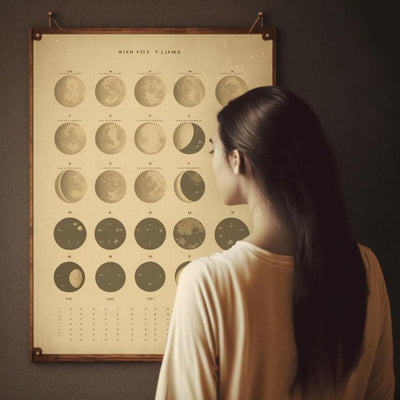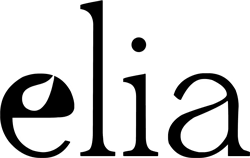Comprendre le calendrier lunaire
27 décembre 2022

Qui n’a pas déjà entendu parler du fameux calendrier lunaire ? Mais si, ce calendrier basé sur les cycles de la Lune, et plus précisément, les différentes phases de la Lune !
L’astrologie est loin d’être une science exacte puisque non prouvée scientifiquement, mais elle continue de faire la une d’articles ou émissions de podcasts. Pourtant, nombreuses sont les personnes qui n’ont qu’une connaissance approximative de la notion de calendrier lunaire. Pas d’inquiétude, Elia s’est penchée sur le sujet du calendrier lunaire, explications !
Définition : qu’est-ce qu’un calendrier lunaire ?
Pour définir la notion de calendrier lunaire, reprenons les bases. Il s’agit d’un système de mesure du temps basé sur les phases de la Lune tout au long de l’année. Il est différent du calendrier grégorien, ou calendrier solaire, fondé quant à lui sur la rotation de la Terre autour du Soleil.Le calendrier lunaire est donc relié avec les phases de la Lune, en sachant que un mois dans le calendrier lunaire correspond à une lunaison, soit une période de temps écoulée entre deux nouvelles lunes.
Le calendrier lunaire peut ainsi servir pour déterminer les dates d'événements (marées, périodes propices à des plantations, fêtes religieuses, etc.). Toutefois, le calendrier lunaire ne prend pas en considération les saisons.
Si à ce stade nous ne vous avons pas perdu, restez encore un peu, cela pourrait vous intéresser très sérieusement !
La durée d’une lunaison est d’environ 29 jours (et si l’on veut pousser le bouchon, nous dirons qu’une lunaison dure 29 jours, 12 heures, 44 minutes et 2 secondes). On parle également de période “synodique” de la Lune, soit la période qui comprend la nouvelle Lune, la pleine Lune, le premier quartier de Lune et le dernier quartier de Lune.
Quelles sont les origines du calendrier lunaire ?
Comme expliqué précédemment, le calendrier lunaire est un système de mesure qui, à l'origine, permettait de repérer les événements et les dates sur de longues périodes de temps en fonction des cycles de la Lune. La date de la nouvelle année lunaire dépend de la position de la Lune et évolue chaque année.
Si l’on remonte dans l’histoire des civilisations, il s’avère que le calendrier lunaire fut l’un des tout premiers systèmes créés pour organiser le temps. Il a d’ailleurs été utilisé par différentes cultures antiques, et notamment en Mésopotamie (calendrier mésopotamien), mais aussi en Assyrie, en Égypte, ou encore en Grèce.
La création d’un calendrier lunaire était en effet plus simple qu’un calendrier solaire pour mesurer le temps, puisque les cycles de la Lune sont moins nombreux et moins complexes que les cycles du Soleil.
Calendrier lunaire et cycle de la lune
Utilisé pour organiser les activités en fonction du cycle de la Lune, le calendrier lunaire a été mis au point à partir des observations humaines depuis la nuit des temps.Le calendrier lunaire est par exemple utilisé en jardinage pour prévoir les semis, les plantations et les récoltes, puisque les phases de la Lune auraient une influence sur le bon développement des plantes. On dit d’ailleurs que les jours de nouvelle Lune et de pleine Lune sont parfaits pour semer ou planter, et que les jours de premier et de dernier quartier de Lune seront plus bénéfiques pour le taillage ou la fertilisation des plantes.
Donc, reprenons : la Lune présente différents cycles en lien avec sa position par rapport au Soleil et à la Terre (position qui détermine la quantité de lumière qui réfléchit sur la Lune) . Jusque là, tout va bien. Ces cycles ont un impact sur les phases de la Lune, qui se répètent chaque mois (la lunaison).
Il est possible d’observer 8 phases de la Lune, chaque mois, que l’on distingue en fonction de la “taille” de la surface qui est éclairée (et visible par nous, petits humains sur Terre), à savoir :
- La nouvelle Lune (la face que nous voyons n’est alors pas éclairée, et la Lune paraît presque invisible) ;
- Le premier croissant ;
- Le premier quartier (la moitié de la Lune est éclairée) ;
- La Lune gibbeuse croissante ;
- La pleine Lune ;
- La lune gibbeuse décroissante ;
- Le dernier quartier ;
- Le dernier croissant.
Calendrier lunaire et lunologie
Le calendrier lunaire est donc un outil ou système de mesure du temps, en fonction des cycles de la Lune. Il se base sur les huit phases de la Lune ainsi que les mouvements lunaires.
La lunologie concerne l'étude de ces différentes phases de Lune et surtout leurs influences (réelles ou ressenties, n’est-ce pas !) sur notre quotidien : sur le plan des émotions, ou encore du sommeil, ou du cycle menstruel.
Calendrier lunaire et astrologie
Si le calendrier lunaire est un système utilisé pour suivre les phases de la Lune (par exemple pour le jardinage), c’est aussi un outil très suivi en astrologie, notamment pour la création des horoscopes.
Pourquoi ? Parce qu’en astrologie, la Lune est un astre associé aux émotions, à la fertilité ou encore à la manière de réagir aux événements. En ce sens, les différentes phases de la Lune auraient une influence sur nos états émotionnels, mais aussi notre corps ou notre sommeil. Le cycle lunaire et l’astrologie sont ainsi intimement liés.
Il existe de très nombreux sites en ligne pour connaître son signe lunaire, c'est-à-dire le signe astrologique correspondant à la position qu’avait la Lune au moment de la naissance d’une personne. Le calendrier lunaire astrologique de l’année en cours est également disponible en ligne sur plusieurs sites Internet, et permet de suivre dans quel signe du zodiaque et dans quelle constellation se trouve la Lune au cours de l’année.
Calendrier lunaire et cycle menstruel
À ce stade de l’article, il fallait bien que nous évoquions ce sujet qui ne cesse de faire la une de certains magazines ou articles d’astrologie. Car oui, comme vous l’aurez peut-être remarqué, le cycle lunaire et le cycle menstruel sont étonnamment similaires. Si le cycle menstruel dure environ 28 jours chez la femme, le cycle lunaire dure quant à lui 29 jours.
Hasard ? Pas selon les aficionados de la lunologie… Pour autant, et malgré les innombrables articles prétendant que le cycle lunaire à une influence sur le cycle menstruel (et donc les menstruations, l’ovulation, la phase lutéale et folliculaire), les preuves scientifiques d’un tel lien sont quant à elle bien absentes ! Il serait même possible de prédire le sexe d’un bébé avec le calendrier lunaire.
L’important est plutôt de s’interroger, en tant que femme, sur ses propres états émotionnels et sa manière d’affronter les événements du quotidien, qui peuvent varier énormément selon notre personnalité, notre passé ou encore notre situation individuelle.
Mais si d’aventure vous êtes déjà convaincue de l’influence du signe du zodiaque sur vos émotions, il se pourrait que les croyances concernant les effets du cycle lunaire sur le cycle menstruel fassent écho à ce que vous ressentez ! Cycle menstruel et lune : peut-être une nouvelle façon de considérer les variations de l’humeur au cours du mois ? À vous de le décider !
La FAQ du calendrier lunaire
Quelle est la différence entre le calendrier lunaire et le calendrier solaire ?
Le calendrier lunaire se base sur le cycle de la Lune, sur 12 mois et 354 jours (soit légèrement plus court que le cycle d’une année solaire). Un mois dans le calendrier lunaire dure en moyenne 29 jours, soit l’écart entre deux nouvelles lunes. Le calendrier solaire se base sur le cycle du soleil, d’environ 365 jours. Le calendrier grégorien, utilisé dans la majorité des pays aujourd’hui, est un calendrier solaire qui comporte 12 mois (365 ou 366 jours selon les années bissextiles).


Commentaires